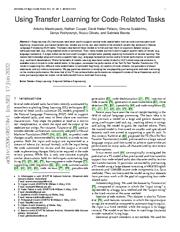A copy of this work was available on the public web and has been preserved in the Wayback Machine. The capture dates from 2022; you can also visit the original URL.
The file type is application/pdf.
Using Transfer Learning for Code-Related Tasks
[article]
2022
arXiv
pre-print
Deep learning (DL) techniques have been used to support several code-related tasks such as code summarization and bug-fixing. In particular, pre-trained transformer models are on the rise, also thanks to the excellent results they achieved in Natural Language Processing (NLP) tasks. The basic idea behind these models is to first pre-train them on a generic dataset using a self-supervised task (e.g, filling masked words in sentences). Then, these models are fine-tuned to support specific tasks
arXiv:2206.08574v1
fatcat:jszf3dckjfejdjndyxn3xkqviq

